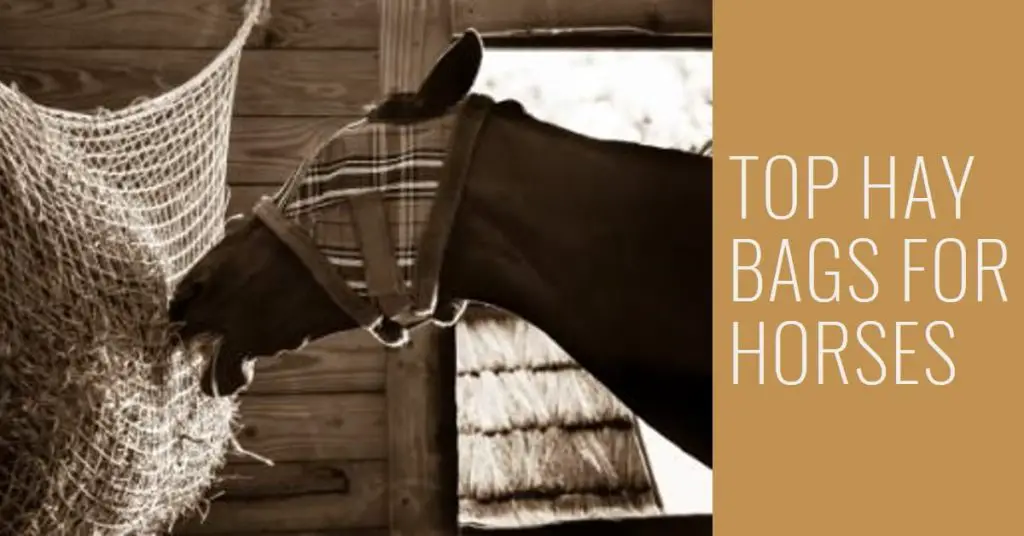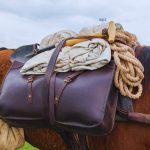Proper nutrition is vital for horses’ health and well-being. As herbivores, they obtain most of their dietary fiber and nutrients from eating hay. Best hay bags offer several advantages to support horses’ hay feeding.
Hay bags allow for controlled portioning of hay to prevent wastage. They also help keep the hay drier for longer by containing it off the ground. Besides, the mental stimulation of retrieving hay from a bag can also help reduce stress levels.
Derby Originals Easy Feeder Horse Hay Bag
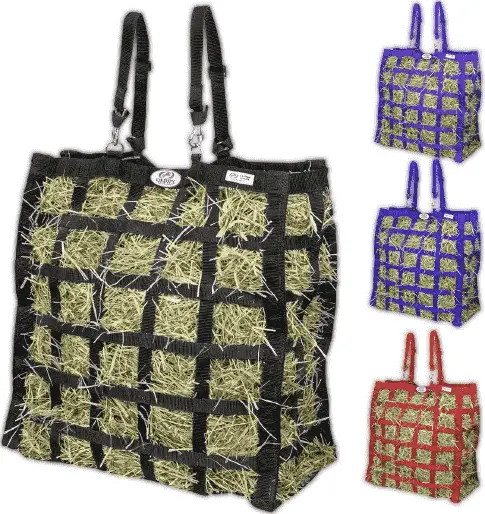
This article provides a detailed review of some of the top-rated hay bags currently available on the market. We evaluate factors such as construction material, capacity, portability and other unique features.
The Derby Originals Easy Feeder Horse Hay Bag lives up to its name. This thoughtfully designed hay bag makes feeding time easier for both horses and their owners.
The bag’s roomy 24x24x10 inch interior can hold 2-3 generous flakes of hay. Hence the reinforced webbed nylon construction and Super Tough overlapping bottom withstand the rigors of daily use. At the same time, rectangular openings spaced around all four sides allow easy access to the hay without waste.
Horses can eat freely from any part of the bag, mimicking natural grazing behavior. Veterinarians recommend slow feeders like this to improve digestion and reduce ulcers, colic and stable vices.
Key Features:
- Holds 2-3 flakes of hay
- Durable 4-sided patented nylon web construction
- Super Tough reinforced nylon webbing bottom
- Improves digestion and reduces risk of colic
- 1-year limited manufacturer’s warranty
What We Love:
- Roomy interior holds multiple flakes of hay
- Openings allow easy access to hay without waste
- Durable construction stands up to wear and tear
- Unique design allows horse to eat from any side
- Super Tough Bottom keeps hay clean and fresh
Things to Consider:
- Not ideal for very coarse or long-stem hay
- Limited warranty does not cover accidental damage
- Replacement can be costly if destroyed by horse
Derby Originals 2” Supreme Nylon Horse Hay Bag

The Derby Originals Slow Feeder Horse Hay Bag is designed to replicate natural grazing behavior by limiting access to hay. This heavy-duty hay net measures 21″ x 7″ x 25″ and can hold 2-3 flakes of hay.
Key Features:
- Super Tough Bottom – Made of reinforced overlapping nylon webbing for superior strength and durability. Allows dust and debris to exit while keeping hay fresh.
- 1.75” Square Openings – Minimizes waste and frustration. Can be easily and quickly stuffed with hay.
- Improves Digestion – Vets recommend slow feeding to prevent colic, ulcers, boredom. Mimics natural grazing.
- Six Month Warranty – Covers manufacturer defects. Does not cover wear and tear or accidental damage.
What We Love:
- Well-constructed with durable, thick nylon webbing
- Easy to detach and hang on stall panels.
- Significantly reduces hay waste and mess.
Things to Consider:
- Several reviewers mentioned the bags unraveling or coming apart at the seams after 2+ years of use.
- May not hold up quite as long as expected with extremely rough use.
Paris Tack Three-Sided Premium Slow Feeder Hay Bag
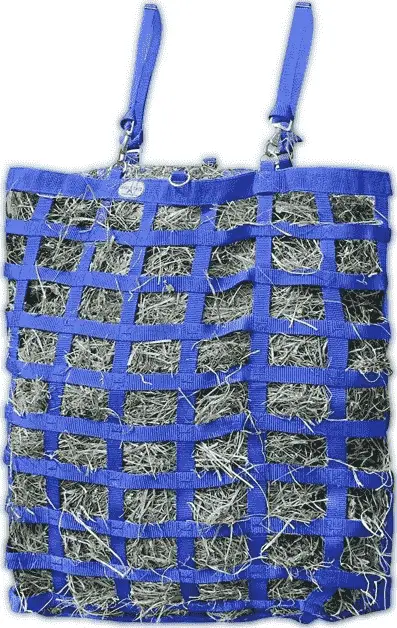
The Paris Tack slow feeder hay bag lives up to its name as a premium, heavy-duty option. It is perfect for slowing down rapid eaters. Made from tough, reinforced nylon with grid stitching at stress points, this bag can withstand years of equine abuse. The exclusive Super Tough Bottom features a reinforced web grid that prevents rips.
With space for 2-3 flakes, the generous 22x10x28-inch bag includes frustration-free 3×2-inch front openings to reduce waste without limiting access. The vibrant colors add a pop to your barn décor.
Key Features:
- Size range accommodates 5 flakes
- Super durable nylon withstands horse abuse
- Reinforced webbed bottom prevents rips
- Slow feed openings reduce waste
- Vibrant color options
What We Love:
- Tough, smart design built to last for years
Things to Consider:
- Could use slightly smaller holes for slower feeding
Weaver Leather Slow Feed Hay Bag
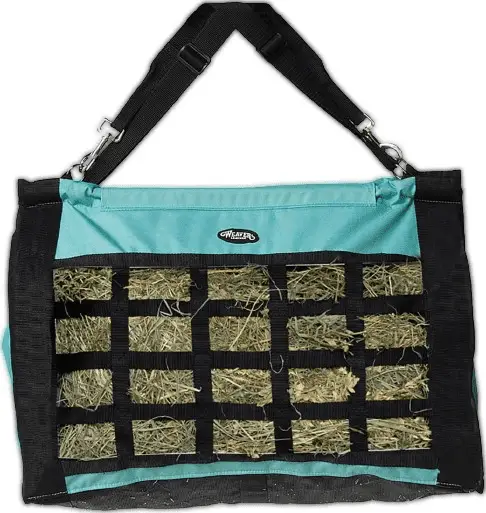
The rugged Weaver Leather hay bag takes slow feeding to the bank with its smart top-loading design. The durable 600 denier polyester stands up to equine abuse while the mesh bottom allows airflow. Adjustable, detachable straps make hanging a breeze.
With room for two average flakes, the generously sized bag features 3 x 2 inch elongated front openings to ensure slow, natural feeding. The mint color adds a pleasant pop of color to your barn.
Key Features:
- 600D polyester built tough
- Holds 2 average hay flakes
- Mesh bottom for ventilation
- Mint colorway pops
What We Love:
- Rugged polyester construction made to last
Things to Consider:
- Larger openings could be slower feeding-friendly
Derby Originals XL Go Around Slow Feeder Horse Hay Bag
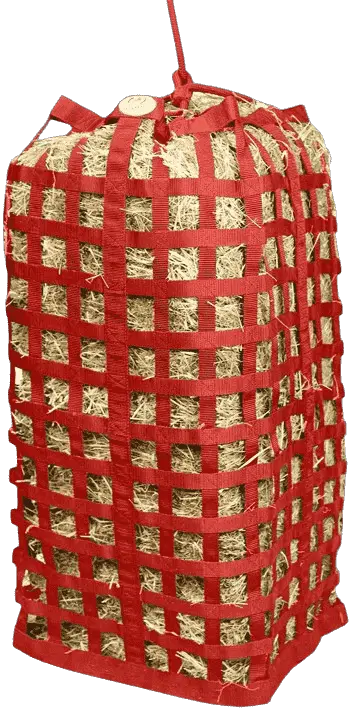
This heavy-duty XL hay bag lives up to its name, easily accommodating full bales in its wide 19 x 19 x 41-inch frame. The exclusive four-sided open weave design allows horses to nibble from any angle while 1.75-inch squares slow consumption freely.
Built from reinforced, cross-stitched nylon, the bag features Derby’s signature Super Tough Bottom grid that prevents annoying rips. The durable construction withstands years of equine abuse for worry-free all day feeding.
Key Features:
- Roomy design holds full bales
- Super Tough rip-proof bottom
- Weather-resistant reinforced nylon
- 1-year limited manufacturer’s warranty
What We Love:
- Spacious bag built to last through years of daily use
Things to Consider:
- Could use interior straps to prevent rotation
Benefits of Using Hay Bags
Hay bags provide several key benefits for horses when used properly.
- The mesh construction regulates intake so hay passes slowly through the digestive tract, promoting more efficient digestion than free-choice hay on the stall floor.
- As horses pull hay strands through small openings, they can’t gorge themselves which prevents overeating.
- Less hay gets wasted since it stays clean inside bags rather than trampled into bedding.
- Bags also allow a more natural head-down grazing posture and nibbling behavior which is mentally stimulating. Since portions are slowed, horses obtain more “occupational time” from their feeding routine as well.
- The restricted access increases the reward value of hay. All of these factors contribute to healthier horses that maintain condition well.
Choosing the Right Horse Hay Bag: Key Factors to Consider
When selecting a hay bag for your horse, several important factors should be taken into account
Age and Health
Younger horses or those with dental issues may benefit from slow-feed bags with smaller openings to encourage natural grazing behavior and prevent digestive problems.
Activity Level: Highly active horses require more hay. Choose a bag with sufficient capacity to meet their daily needs.
Temperament: Nervous or aggressive horses might need a sturdy bag that can withstand pawing or tossing.
Hay Bag Type
Slow-Feed vs. Regular Bags:
Slow-feed bags:
Encourage nibbling, reduce waste, and mimic natural grazing. Ideal for horses prone to boredom, colic, or weight gain.
Regular bags:
Offer quicker access but can lead to overconsumption and hay waste.
Mesh vs. Nylon:
Mesh bags:
Lightweight, well-ventilated, and easy to clean but may snag teeth or encourage faster eating.
Nylon bags:
It is more durable, weatherproof, and comes in slow-feed options but can be heavier and hold heat.
Hanging vs. Stall Bags:
Hanging bags:
Save floor space and keep hay clean, but require secure hanging points.
Stall bags:
Offer portability and ground feeding, but hay can get soiled.
Material and Construction
Durability:
Choose strong materials like nylon or canvas that resist wear and tear from teeth and hooves.
Closures:
Look for secure closures like buckles or straps to prevent hay spillage.
Cleaning:
Opt. for easy-to-clean materials that can be hosed down or machine-washed.
Additional Features
Size:
Ensure the bag is large enough to hold the desired amount of hay without being overwhelming for your horse.
Attachments:
Some bags have clips or straps for easy hanging or securing installs.
Ventilation:
Good ventilation prevents mould and mildew growth, especially in humid climates.
Safety:
Avoid sharp edges or loose threads that could injure your horse.
Price:
Hay bags range in price depending on size, material, and features. Choose a quality bag that fits your budget and horse’s needs.
Remember:
Consider consulting your veterinarian for specific recommendations based on your horse’s individual health and situation.
By carefully considering these factors, you can select the perfect hay bag to keep your horse happy, healthy, and well-fed.
Hay Bag Maintenance & Cleaning: Quick Guide
- Deep clean every 1-2 weeks, spot clean regularly.
- Soak in lukewarm water with vinegar & baking soda (gentle), or equine net cleaner (heavy).
- Scrub with a brush/sponge, rinse thoroughly.
- Hang to dry completely in shade & ventilation.
- Wash straps & attachments separately.
- Repair tears & loose threads promptly.
- Inspect for wear & tear and replace when needed.
- Avoid harsh chemicals & bleach.
- Consider hay feeder liner for easier cleaning.
- Mesh bags: May need more frequent cleaning.
- Nylon bags: May require soaking & scrubbing.
- Slow-feed bags: Check for trapped hay & clean thoroughly.
Janet G Kulick is an experienced horse rider, trainer, and owner of the informative horse blog, Horseray.com. Her engaging writing style and wealth of knowledge on horse care, riding, and training make her a trusted source for horse enthusiasts worldwide.

